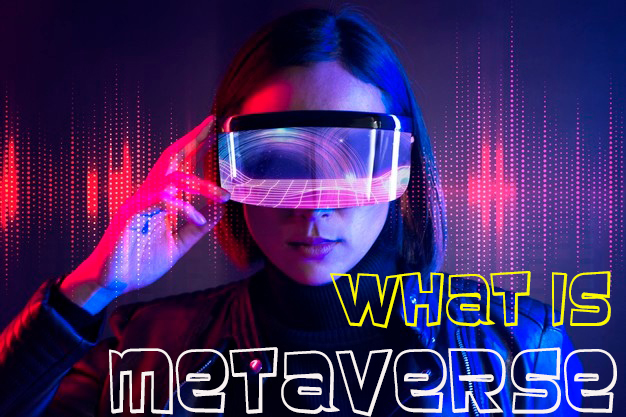What is the metaverse?
The metaverse a
portmanteau of "meta-" and "universe") is a conjectured
emphasis of the web, supporting persevering internet-based three-dimensional
virtual environments through regular individualized computing, just as virtual
and expanded reality headsets. Metaverses, in some restricted structure, are
now present on stages like VRChat or computer games like Second Life.
Metaverse is a combination of multiple elements of technology, including virtual reality, augmented reality, and video where users "live" within a digital universe. Supporters of the metaverse envision its users working, playing, and staying connected with friends through everything from concerts and conferences to virtual trips around the world.
Metaverse definition.
The metaverse is a hypothesized iteration of the internet, supporting persistent online 3-D virtual environments through conventional personal computing, as well as virtual and augmented reality headsets. Metaverses, in some limited form, are already present on platforms like VRChat or video games like Second Life.
It's a combination of multiple elements of technology, including virtual reality, augmented reality and video where users "live" within a digital universe. Supporters of the metaverse envision its users working, playing and staying connected with friends through everything from concerts and conferences to virtual trips around to the world.
"Right now, we are on the cusp of the next internet," said Matthew Ball, managing partner of venture capital firm Epyllion Industries, in a February 2021 essay on his website.
The Metaverse Has Already Arrived. Here’s What That Actually Means
Momentum
metaverse aspirations are focused on tending to innovative restrictions with
present-day virtual and increased reality devices just as growing the
utilization of metaverse spaces to business, instruction, and retail
applications. Numerous amusement and online media organizations have put
resources into metaverse-related exploration and development.
Metaverse Like Right Now?
The paradox of defining the metaverse is that in order for it to be the future, you have to define away the present. We already have MMOs that are essentially entire virtual worlds, digital concerts, video calls with people from all over the world, online avatars, and commerce platforms. So in order to sell these things as a new vision of the world, there has to be some element of it that's new.
Spend enough time having discussions about the metaverse and inevitably someone will reference fictional stories like Snow Crash—the 1992 novel that coined the term “metaverse”—or Ready Player One, which depicts a VR world where everyone works, plays, and shops. Combined with the general pop-culture idea of holograms and heads-up displays (basically anything Iron Man has used in his last 10 movies) these stories serve as an imaginative reference point for what the metaverse—a metaverse that tech companies could actually sell as something new—could look like.
The
metaverse has come to be condemned as a strategy for advertising building
utilizing a simply theoretical, "over-advertised" idea dependent on
existing innovation. Data security and client fixation are worries inside the
metaverse, originating from current difficulties confronting the online media
and computer game ventures in general
Use of Holograms technology in Metaverse?
When the
internet first arrived, it started with a series of technological innovations,
like the ability to let computers talk to each other over great distances or
the ability to hyperlink from one web page to another. These technical features
were the building blocks that were then used to make the abstract structures we
know the internet for: websites, apps, social networks, and everything else
that relies on those core elements. And that's to say nothing of the
convergence of the interface innovations that aren't strictly part of the
internet but are still necessary to make it work, such as displays, keyboards,
mice, and touchscreens.
With the
metaverse, there are some new building blocks in place, like the
ability to host hundreds of people in a single instance of a server (ideally
future versions of a metaverse will be able to handle thousands or even
millions of people at once), or motion-tracking tools that can distinguish
where a person is looking or where their hands are. These new technologies can be
very exciting and feel futuristic.
However,
there are limitations that may be impossible to overcome. When tech companies
like Microsoft or Fa—Meta show fictionalized videos of their visions of
the future, they frequently tend to gloss over just how people will
interact with the metaverse. VR headsets are still very clunky, and most
people experience motion sickness or
physical pain if they wear them for too long. Augmented reality glasses face a
similar problem, on top of the not-insignificant issue of figuring out how
people can wear them around in public without looking like huge dorks.
So, how do
tech companies show off the idea of their technology without showing
the reality of bulky headsets and dorky glasses? So far their primary solution
seems to be to simply fabricate technology from whole cloth. The holographic
woman from Meta's presentation? I hate to shatter the illusion, but it's simply
not possible with even very advanced versions of existing technology.
Unlike
motion-tracked digital avatars, which are kind of janky right now but could be
better someday, there's no janky version of making a three-dimensional picture
appear in midair without tightly controlled circumstances. No matter what Iron
Man tells you. Perhaps these are meant to be interpreted as images projected
via glasses—both women in the demo video are wearing similar glasses, after
all—but even that assumes a lot about the physical capabilities of compact
glasses, which Snap can tell you isn't
a simple problem to solve.
This kind of
glossing over reality is frequently present in video demos of how the metaverse
could work. Another of Meta's demos showed
characters floating in space—is this person strapped to an immersive aerial rig
or are they just sitting at a desk? A person represented by a hologram—does
this person have a headset on, and if so how is their face being scanned? And
at points, a person grabs virtual items but then holds those objects in what
seems to be their physical hands.
This metaverse demo raises so many more questions than it answers.
However, this
kind of wishful-thinking-as-tech-demo leaves us in a place where it's hard to
pinpoint which aspects of the various visions of the metaverse will actually be
real one day. If VR and AR headsets become comfortable and cheap enough for
people to wear on a daily basis—a substantial “if”—then perhaps the idea of a
virtual poker game where your friends are robots and holograms and floating in
space could be somewhat close to reality. If not, well you could always
play Tabletop Simulator on a Discord video call
The
flashiness of VR and AR also obscure the more mundane aspects of the metaverse
that might be more likely to come to fruition. It would be trivially easy for
tech companies to invent, say, an open digital avatar standard, a type of file
that includes characteristics you might enter into a character creator—like eye
color, hairstyle, or clothing options—and let you take it everywhere. There's
no need to build a more comfortable VR headset for that.
But metaverse not as fun to imagine.
When can we expect to see it?
Facebook founder Mark Zuckerberg, the CEO of the newly named Meta (formerly Facebook), estimates it could take five to 10 years before the key features of the metaverse become mainstream. But aspects of the metaverse currently exist. Ultra-fast broadband speeds, virtual reality headsets and persistent always-on online worlds are already up and running, even though they may not be accessible to all.
The Vision
What does exist for sure, argue proponents like Tatsu, is the already realized potential for the metaverse to increase empathy and inspire kindness.
“I think that when you’re in a virtual space, they’re usually smaller, they’re usually more intimate. And I think that when we move into this world, where you really customize your avatar, you develop a more intimate relationship with the people you have online,” she says. “Even though you’re behind a screen or you’re behind a headset, you still see somebody.”
A few years ago, a surreal YouTube video made its way around the internet. In the middle of a standard VRChat session, which is itself a mosh pit of clashing avatars and frenetic voice chat, a user who was wearing a full-body tracking suit apparently had a seizure. The episode underscored not only the actual distance between people in virtual spaces but also the outpouring of concern for the person behind a red robot avatar.
Hackl sees the upcoming shift in technologies as a chance to shape a more inclusive mission and purpose. “I feel we’re working on the printing press of the future,” she says, ”being able to preserve, let’s say, a language that is soon to disappear. If you’re able to retain not only in a flat video, you’ll see the sound and you’ll see the movement of lips and stuff. In a 3D performance capture and an actual 3D video, you’ll be able to see a lot of the nuances of how the tongue moves, and the teeth move, and you’ll be able to preserve the same dances as well as artifacts, stories, all sorts of things. I believe that that is something we’re working on today to preserve those stories for the future.”
To her, that future will be a better one, thanks in part to the metaverse.
“When I look at the architects of the internet, they were all men,” Hackl says. “Being a Latina woman that is very publicly out there, I want more people like me. We need to see people like me, in these public-facing roles, because you can inspire a lot more people to join and say, ‘Hey, I am welcome in this metaverse world. I can build.’”
For those whose lives are already being lived partly in the metaverse—despite its pitfalls and risks—that building has begun.
meta,metaverse,what is meta,connect,facebook meta,mixed reality,instagram,messenger,augmented reality,facebook metaverse,connect2021,metaverse explained,connect 2021,what is facebook meta,what is the metaverse,facebook name,oculus connect,virtual reality,mark zuckerberg,connect keynote,facebook changed its name,facebook rebrand,facebook keynote,what is metaverse facebook,facebook connect,new facebook name,new facebook brand,oculus connect 2021,







1 Comments
well information about latest technology
ReplyDeletedon't spam comments, please ...